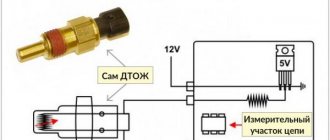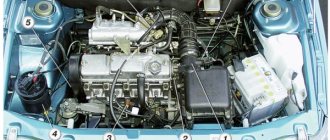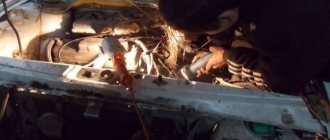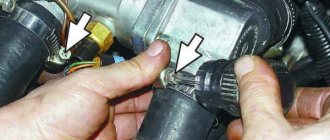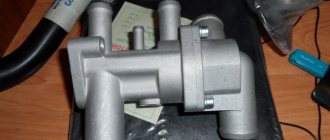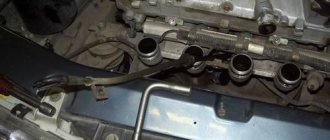To ensure safe and stable thermal conditions of an internal combustion engine, precise operation of the cooling system is required. The slightest failure will lead to overheating of the engine, which can lead to burnout of the head gasket or failure of the piston group elements.
The radiator fan is one of the key components of the car cooling system. Its role is to promptly force cool the liquid in the radiator. Problems with turning it on are a common occurrence for our cars.
In this article we will talk about possible reasons why the VAZ-2110 cooling fan does not work, and also consider options for eliminating them. But first, let's understand its design and operating principle.
How does the fan turn on?
Unlike carburetor engines, in VAZ 2110 injection engines the fan is turned on not directly from the temperature sensor, but through the electronic control unit (ECU). The sensor is installed on the outlet pipe of the cylinder head.
VAZ 2110 injector cooling fan does not turn on: reasons, how to check
When the coolant heats up to a temperature of 100-107 0 C, the sensor is triggered and sends a signal to the ECU, which processes it and sends it to the relay. The relay closes the circuit and supplies power to the fan drive (electric motor) through a fuse.
Tuning and repair of VAZ 2110
In this article we will look at such a process as removing the VAZ 2110 radiator fan. Why remove it? Well, there can be many reasons - starting from problems with the fan itself, ending with getting to the radiator.
What will be required for such a repair? Just a 10mm wrench and a Phillips screwdriver.
First of all, we prepare the car for removing the fan, for this:
- We partially drain the antifreeze so that you can unscrew the upper radiator pipe and prevent coolant from flowing out of it.
- Unscrew the terminals from the battery and remove it.
- We tear off the air filter housing from the rubber clips. For convenience, so that it does not interfere at all, unscrew the clamp of the pipe connecting to it and disconnect the folded corrugation from below.
4. Disconnect the fan power terminal.
5. Next, we will need an open-end or socket wrench “10”. Unscrew the nut of the lower fan mounting.
6. Now the top one. (In some VAZ 2110 models there are 2 nuts for fastening the fan. In 16-valve models there is one nut at the top and on the side).
7. Next, loosen the clamp on the upper radiator pipe and remove the pipe.
8. Now you can lift the fan up.
This completes the process of removing the VAZ 2110 radiator fan.
Next, let's look at the process of disassembling the radiator fan.
For this type of work, in addition to a “10” wrench and a screwdriver, you will need a “13” wrench.
- Using a 10mm wrench, unscrew the fan motor from the plastic casing.
2. Remove the clip that holds the wiring harness.
3. Next, using a “13” wrench, unscrew the impeller fastening nut. At the same time, hold the impeller so that it does not rotate.
So we removed the VAZ 2110 radiator fan from the car and disassembled it.
Source
Reasons why the fan may not turn on
Considering the described switching process, the reasons for the fan not working may be:
- faulty temperature sensor;
- faulty relay;
- blown fuse;
- electrical circuit break;
- Problems with the electric fan drive.
In addition, the expansion tank cap can also affect the timely activation of the fan. If it is faulty and its valve is not capable of maintaining pressure above atmospheric, the water, which is part of the coolant, will definitely boil at 100 0 C, and the sensor set to a higher temperature will not have time to operate.
Expansion tank cap
The last reason why the VAZ-2110 cooling fan does not work may be a malfunction of the expansion tank cap. The fact is that when the engine is running, a pressure above atmospheric pressure is created in the cooling system, due to which the water, which is part of the coolant, does not boil at 100 o C. The expansion tank cap valve is designed to maintain the required pressure. If it fails, the pressure in the system will be equal to atmospheric pressure. This will cause the coolant to begin to boil already at 100 degrees. A sensor designed to turn on at a higher temperature will naturally not work.
It is unlikely that you will be able to check the operation of the cover at home, so if during a visual inspection you have doubts about its functionality, it is better to replace it immediately.
Source
How to check the fan circuit
1. We start the test with the simplest thing - determining the condition of the fuse. We are looking for it in the mounting block, which is located under the hood. Its marking is F7.
2. We take it out, and visually, or using a multimeter, check for functionality. If it burns out, replace it with a new one (20 A). If everything is fine with him, we put him in his place and move on.
3. In order not to waste time, it is better to immediately determine the functionality of the fan motor. To do this, disconnect the wires from it and connect it directly to the battery, observing the polarity. If the fan is “alive”, we continue to look for the cause.
4. Move on to the fan relay. It is located in an additional mounting block in the car interior to the left of the front passenger's feet.
5. There are three relays there. Ours is on the far left.
It is unlikely that you will be able to check it yourself; it is better to take another one somewhere and put it in the place of the person being checked. We heat the motor to maximum temperature and observe the behavior of the fan. If there is no result, move on.
Unscrew and inspect the cap of the expansion tank. At the slightest suspicion of leakage, throw it away and install a new one.
Next we move on to the sensor itself. We start the engine, heat it to a temperature of more than 100 0 C, and disconnect the connectors from the sensor. The ECU that controls the operation of the sensor should automatically send a signal to the relay to force the fan to turn on. If the fan turns on, the problem is most likely in the sensor. We replace the sensor with a new one and check its operation.
If nothing works here, you need to look for an open circuit in the electrical circuit. To do this, it is better to contact specialists.
Source
Procedure. Step-by-step instruction
If after completing the next step the problem goes away, further checks are stopped.
- Open the hood.
- Wait for the engine to cool down.
- Perform an initial visual inspection: integrity of the hoses, reliability of the clamps, absence of leaks or cracks.
- Make sure that the expander cover elements are in good condition. Remove scale, rust, clear holes, wipe, assemble. The absence of noticeable damage to parts gives hope that the product will work.
The valve design is elementary. The cover contains a spring. Functionally, it is designed to regulate the pressure in the cooling circuit. A hot engine increases it, a cold engine decreases it.
Compressing at a value of 1.1 atmospheres, the spring relieves excess pressure and prevents the destruction of hoses and the tank. As the motor cools, it creates a vacuum effect. The tank will begin to flatten. The valve equalizes the pressure.
Design
Cooling system diagram
The cooling system includes many components. Among those that interest us today, which can cause problems with the radiator fan, we note:
- Electric fan. This unit starts working when the coolant temperature reaches 100-105 degrees Celsius;
- Fan switch sensor. It is configured to operate precisely within the specified temperature range. The sensor is located on the inlet pipe of the cylinder block (labeling from the sensor factory is LS0112);
- Fuse marked F7. It is located in the mounting block;
- Fan relay. You will find this unit already in the cabin, under the right panel of the front console.
If the radiator fan does not work on your VAZ 2110, the cause of the malfunction should be looked for in the above-mentioned system elements. Although there may be one situation in which the electrical circuit has nothing to do with the fault.
What is a fan switch sensor? Maintenance and replacement of DVV VAZ 2110 | VAZ REPAIR
The fan switch sensor ( DVS ) is part of the engine cooling system and performs almost the same function as the thermostat.
If the engine temperature rises to a certain level, the sensor sends a signal to the ECU, after which the fan turns on and increases cooling of the engine radiator.
The fan removes heat from the radiator by forcing a flow of air onto the radiator fins.
The main task of the fan switch sensor, as well as the thermostat, is to prevent the engine from overheating.
The DVV on the VAZ 2110 is located on the radiator housing; if it malfunctions, it cannot be repaired and requires immediate replacement.
The fan is switched on and off automatically; in this chain, the fan switch on sensor acts solely as a signaling device.
How to check the fan switch sensor on a VAZ 2110?
- After the coolant temperature rises to a critical level, the fan switch initiates operation of the fan unit; if this does not happen, then there is a malfunction in the cooling system.
- In order to find the reason, it is not at all necessary to go to a service station; it is enough to conduct a simple test that will allow you to understand what is going on.
- You need to close the contacts of the device and look at the reaction of the fan; if it works, you need to replace the fan switch sensor.
- It also wouldn’t hurt to check the serviceability of the fan fuse; if it doesn’t work, replacing the DVV will not give any result, and the money will be wasted.
- Check the condition of the wiring; perhaps the reason is not in the sensor, but in the power supply or a connection to ground.
How to check the fan switch sensor using a multimeter?
To check, you will need water, an empty container, a thermometer and a heat source (gas or electric stove). Checking the fan switch sensor is no different from checking the thermostat.
- The principle is as follows: you need to pour water into the container.
- Lower the threaded part of the DVV there.
- Connect the multimeter terminals to the sensor contacts and turn the device into resistance measurement mode, or into “continuity” mode.
- Now gradually heat the water.
- After the water temperature reaches ~92°, the contacts of the working fan switch sensor should close, after which the multimeter should make a sound.
If you are convinced that the sensor is faulty, replace the sensor.
Do-it-yourself replacement of the VAZ 2110 fan switch sensor
- Remove the “-” terminal of the battery.
- Next, drain the coolant from the radiator and turn off the power from the fan switch sensor.
- Then you need to unscrew the DVV from the radiator housing, and install a new fan switch sensor in its place.
Safety valve
Knowing physics, you will agree that at normal atmospheric pressure, the water that is part of antifreeze boils at a temperature of 100 degrees Celsius.
Old device
To fix this problem, replace the expansion tank cap. The new element must maintain the pressure inside the system above atmospheric pressure, which will allow the laws of physics to work, the boiling temperature to rise to 105 degrees Celsius and thereby turn on the blades of the unit.
Electrical circuit malfunctions
If everything is fine with the tank cap and there are no problems with pressure, then the causes of the radiator cooling malfunction should be sought in its electrical circuit.
- The search begins with checking the functionality of the fuse marked F7. To do this, you have to get to the mounting block. Check the quality of the contacts and the presence of traces of oxidation. If everything is good here, we move on. If the contacts are broken, simply clean them, or simply change the fuse. This is a small financial cost.
- The next place to check will be the VAZ 2110 fan switch sensor. You do not have to go to a specialized service station to check the efficiency of the sensor. This is done in a garage: Warm up the engine of your car to above 100 degrees Celsius;
- Turn off the engine, then start the engine again;
- Lift the hood and remove the terminal from the VAZ 2110 fan sensor;
- If after removing the element the fan begins to spin, then the unit is working properly, but there are problems with the sensor;
- When on a VAZ 2110 the cooling system fan does not turn on after disconnecting the terminal, the situation is the opposite - the fan does not work, but the sensor is in good condition.
- The commutator brushes are worn out;
- The trim on the right side of the console inside the cabin is removed by unscrewing two screws;
Problems with the electrical circuit
If checking the reservoir cap does not reveal any faults, then the problem may lie in the circuit.
The search should begin by checking the serviceability of fuse F7. To do this, you need to gain access to the mounting block and check the contacts for the presence of oxidative traces. If nothing of the sort was noted, then proceed to the next step. Otherwise, clean the contact connections or simply replace the fuse with a new element. The part is inexpensive.
The next step is to check the fan switch sensor:
- Initially, warm up the car to 100 degrees.
- Turn off the engine and immediately start the engine.
- Open the hood and disconnect the terminal from the fan sensor.
- If, after disconnecting the contact, the fan starts working, then the unit is operational, but the sensor needs to be replaced.
- When the fan does not turn on after disconnecting the terminal, then the situation is the opposite - the sensor is working, but the fan is not.
Electric motor breakdowns are often the reason why the fan does not turn on. If all the previous measures did not help you find the problem, then you will need to dismantle the electric motor. The following problems can be identified in this node:
- The commutator brushes are worn.
- The brushes are stuck.
- There was a short circuit in the armature winding - the problem is identified by a characteristic smell.
Problems with the relay. Sometimes a situation arises when the cooling system fan start button simply fails. In this case, you will need to carry out the following work:
- Remove the trim on the right side of the dashboard inside the passenger compartment. To do this, you need to unscrew two screws.
- Under this panel there are three relays.
- The required relay is usually located on the side in relation to the front of the car.
- To be sure to act correctly, find the car's operating manual and check the wires that go to the relay we need.
- To solve the problem with the relay, you just need to install a new element. You should not skimp on this component. Cheap models break down very quickly.
Constantly running fan
In some situations, the cooling fan may run continuously, regardless of whether the engine is cold or hot. In this case, there may be various reasons, corresponding methods for checking the malfunction, as well as ways to solve the breakdown.
| Causes | Diagnostics | How to fix the problem |
| Open circuit in the coolant temperature sensor or its circuits | The “Check engine” lamp is on. The sensor and circuits need to be checked with an ohmmeter | Replace sensor |
| The electric fan relay contacts do not open | Check with a multimeter | Replace relay |
| The injection system control unit or its circuit (ECU) is faulty | Check the unit at a specialized car service center | Replace the ECU firmware or the unit itself |
| (Carburetor) Radiator thermal switch contacts do not open | Disconnect the terminals from the thermal switch terminals. After this, the electric fan will stop working. | Replace thermal switch |
Injector sensor for turning on the blower
Proven and reliable car services will be able to conduct full computer diagnostics of the cooling system and determine the reasons for the cooling fan not working. The problem may be much larger than a blown fuse.
Don't be afraid to turn to specialists, even if you consider yourself an experienced auto mechanic who has always solved your car's problems on your own. Modern equipment, a professional approach, computerization of car services - all this allows you to quickly determine the causes of malfunctions, which, according to your old-fashioned method, would have taken several days. Auto repair shops also have their advantages.
Source
Circuit diagram for switching on the cooling fan for a VAZ 2110 carburetor engine.
The circuit diagram for switching on the cooling fan of the VAZ 2110 on carburetor and injection cars is different. On cars with a carburetor engine, a thermobimetallic sensor TM-108 is used for this, and on cars with an injection engine, control is carried out by a controller.
When the fan is controlled by a sensor, the switching temperature depends on the sensor setting temperature, which is indicated on the housing. If the fan does not turn on when the temperature rises to the sensor response temperature, you must first check the serviceability of the sensor. To check, just close the contacts on the sensor and if it turns on, you need to change the sensor. If after closing the terminals the fan does not work, then the cooling fan switching circuit and the integrity of the fuse need to be checked.
The principle of operation of the cooling system of the VAZ 2110 injector 16 valves
The design is a closed circuit, inside which coolant is pumped through a centrifugal pump. The radiator releases the temperature generated by the engine into the atmosphere. The sensor installed on the thermostat pipe senses the coolant heating threshold of 105 - 107 degrees Celsius, provides information to the controller. The controller sends a signal to the relay, starting the electric motor of the fan. The radiator honeycombs are blown.
The principle of operation of the cooling system of the VAZ 2110 injector 16 valves: 1 - heater radiator; 2 — coolant drain hose from the heater radiator; 3 — coolant supply hose to the heater radiator; 4 — coolant pump hose; 5 — expansion tank hose; 6 — steam removal hose of the heater radiator; 7 — expansion tank cap; 8 — expansion tank; 9 — thermostat; 10 — coolant drain hose from the engine radiator; 11 — hose for supplying fluid to the throttle assembly; 12 — steam exhaust hose of the engine radiator; 13 — hose for supplying fluid to the engine radiator; 14 — engine radiator; 15 — radiator drain plug; 16 — electric engine radiator fan; 17 — coolant pump; 18 — supply pipe of the coolant pump; 19 — coolant drain hose from the throttle body.
Safety regulations
- Open the expansion tank cap after the engine has cooled down.
- When working under the hood, beware of rotating blades and a hot engine.
- Use auxiliary, serviceable conductors with a cross-section of 2 mm.
- Use standard fuses of the required rating.
- Use a proper tool.
- Insulate “bare” contacts, avoiding short circuits in the electrical wiring.
Why does the fan on the VAZ not work?
- - flat screwdriver;
- - side cutters or pliers;
- — wire with a cross-section of at least 0.75 sq. mm in insulation;
- - insulating tape;
Take your car's electrical diagram and find the components responsible for controlling the electric fan. First of all, check the integrity of the electrical fuse. Please note that older cars did not use an electric fan; instead, an impeller was installed on the pump, which rotated constantly. This type of radiator airflow is good because it provides better cooling in hot weather. But in cold weather, the engine takes longer to reach operating temperature, so you have to cover the radiator with cardboard or a piece of plastic in the winter.
The fan does not turn on.
But there are malfunctions in which the controller does not recognize the malfunction and the fan may not turn on when the temperature reaches above 105 degrees. C. In this case, to check the circuit and sensor, it is necessary to remove the connector from the temperature sensor while the engine is running. If the circuit is working properly and the sensor is malfunctioning, the fan will turn on and turn off when the connector is returned to its place.
If the circuit malfunctions, it is necessary to check the integrity of the fuse, the serviceability of the relay and wires, according to the circuit. For a quick check, you need to bridge terminals 30 and 87 of the fan relay, located in the heater shaft on the passenger side. If the fan works, without removing the relay from the block, connect the case and pin 86 of the relay with a test lamp, the relay should work and the fan should turn on. In this case, the controller or the wire connecting the relay to pin 46 of the controller is faulty.
If you do not hear the characteristic click of the relay turning on, and a positive signal is supplied from the main relay to pin 85 of the relay, and if there is a click and the fan does not turn on, change the relay. When installing a jumper between pins 30 and 87 does not turn on the fan, check the integrity of the fuse and the presence of power at the fan terminals. If there is power on one terminal and no power on the other, this indicates a possible malfunction of the fan motor.
Scheme for switching on the cooling fan of an injection engine.
- Scheme for switching on the cooling fan VAZ 2107 carburetor
06/09/2011 “If you notice an error in the text, please highlight this place with the mouse and press CTRL+ENTER” “If the article was useful to you, share the link to it on social networks”
To ensure safe and stable thermal conditions of an internal combustion engine, precise operation of the cooling system is required. The slightest failure will lead to overheating of the engine, which can lead to burnout of the head gasket or failure of the piston group elements.
The radiator fan is one of the key components of the car cooling system. Its role is to promptly force cool the liquid in the radiator. Problems with turning it on are a common occurrence for our cars.
In this article we will talk about possible reasons why the VAZ-2110 cooling fan does not work, and also consider options for eliminating them. But first, let's understand its design and operating principle.
Cooling system
Typically, the cooling system of any car consists of the following elements:
- radiator;
- BC cooling jacket;
- thermostat;
- connecting pipes and hoses;
- centrifugal pump;
- fan with electric motor.
And if some device malfunctions, then on a VAZ-2110 with an injector the cooling fan does not turn on.
Every element is necessary for the proper operation of the entire system, but the fan is still one of the important components. Its task is to cool the radiator and, accordingly, the liquid passing through it, when necessary. If it stops turning on, this affects the performance of the entire system.
Causes of malfunction
If the radiator fan refuses to start, check the items in the following order:
- Fuse - Check this fuse element for continuity in the fuse block. It is located there under the number F7 and has a rating of 20 amperes. The fan fuse is yellow F7. (editing machine mounting block, 124 engine)
- The relay responsible for the operation of the electric fan is located, together with additional relays, next to the left foot of the front passenger. The easiest way to check is by connecting a known good relay. If after such dismantling everything works, the problem is solved, if not, then read below. The relay is located under the number “4”.
- Thermostat - since the liquid first circulates in a small circle without heating the sensor and radiator. It is easy to check if the thermostat is malfunctioning; just touch the two pipes going to the radiator; if one of them is cold on a well-warmed engine, then the thermostat is faulty and needs to be replaced.
- Temperature sensor - to diagnose a malfunction of this element, on a warm engine, disconnect the power connector from it, thereby you will force the fan motor to start. If it still does not start, then the problem lies in the electric motor itself. It is worth checking the sensor and replacing it if necessary.
- Fan motor - in order to check this element, you need to disconnect the power supply and connect it directly to the battery. If the fan is working, it will start, and if it fails, look for a problem in the wiring or change the fan assembly. You can try to repair the electric motor.
Fan connection diagram in carburetor and injection engines
The control of forced radiator airflow in carburetor and injection engines of the VAZ-2110 is significantly different. Firstly, the fan switch located on the radiator housing is responsible for everything. It is set to a certain coolant temperature. Usually it is 105-107 oC. When the coolant heats up to this temperature, the sensor is triggered, sending a signal to the fan relay. It closes the electrical circuit, driving the electric motor.
- Coolant temperature sensor: where it is located, how to check and replace
Turning on the cooling fan of a VAZ-2110 with an injection engine occurs somewhat differently. In engines equipped with an electronic control unit, there is no sensor on the radiator. Its place was taken by a temperature sensor located on the thermostat pipe. When the coolant heats up to a temperature of 105-107 oC, it sends a signal directly to the controller, which makes the decision to turn on the fan. It transmits an electrical impulse to a relay, which turns on the electric drive.
VAZ 2110 fan switch on sensor to guard the engine temperature
The standard fan switch-on sensor is designed to trigger the relay during a period when the temperature of the liquid intended to cool a running motor reaches certain values, above which the engine will overheat.
Often, novice car enthusiasts ask the question where the fan switch on for the VAZ 2110, and other passenger cars, is located. We inform you that such a device is located on the car radiator. This device cannot be repaired and replacing the fan switch sensor if it fails is the only solution.
On the “ten”, however, like on many other cars with liquid cooling of the power plant, an electrically driven climatic fan unit is used to stabilize the operating temperature of the engine. Putting the fan into operating mode, as well as taking it out of this position, takes place automatically, and the fan switch-on sensor serves as a signaling device in case of emergency exceeding of temperature values.
If the “ten” is equipped with a carburetor-type engine, then to perform the function of warning about overheating of the power plant, a TM-108 thermobimetallic type cooling fan switching sensor is used, while in VAZ 2110 injectors these functions are assigned to the controller.
If the fan installation is “commanded” by the fan switching sensor, then its initiation is directly related to the temperature setting of this device. This information can be obtained by reading the labels on the product body.
When the temperature reaches critical values, the fan switch sensor must initiate operation of the fan unit. If this does not happen, you should look not only where the fan switch sensor is located, but also the malfunction of this control device.
The test for the functionality of the device is quite simple - you just need to short-circuit the contacts of the device and, if the fan unit works when it starts, then you need to replace the fan switch sensor with a working element.




